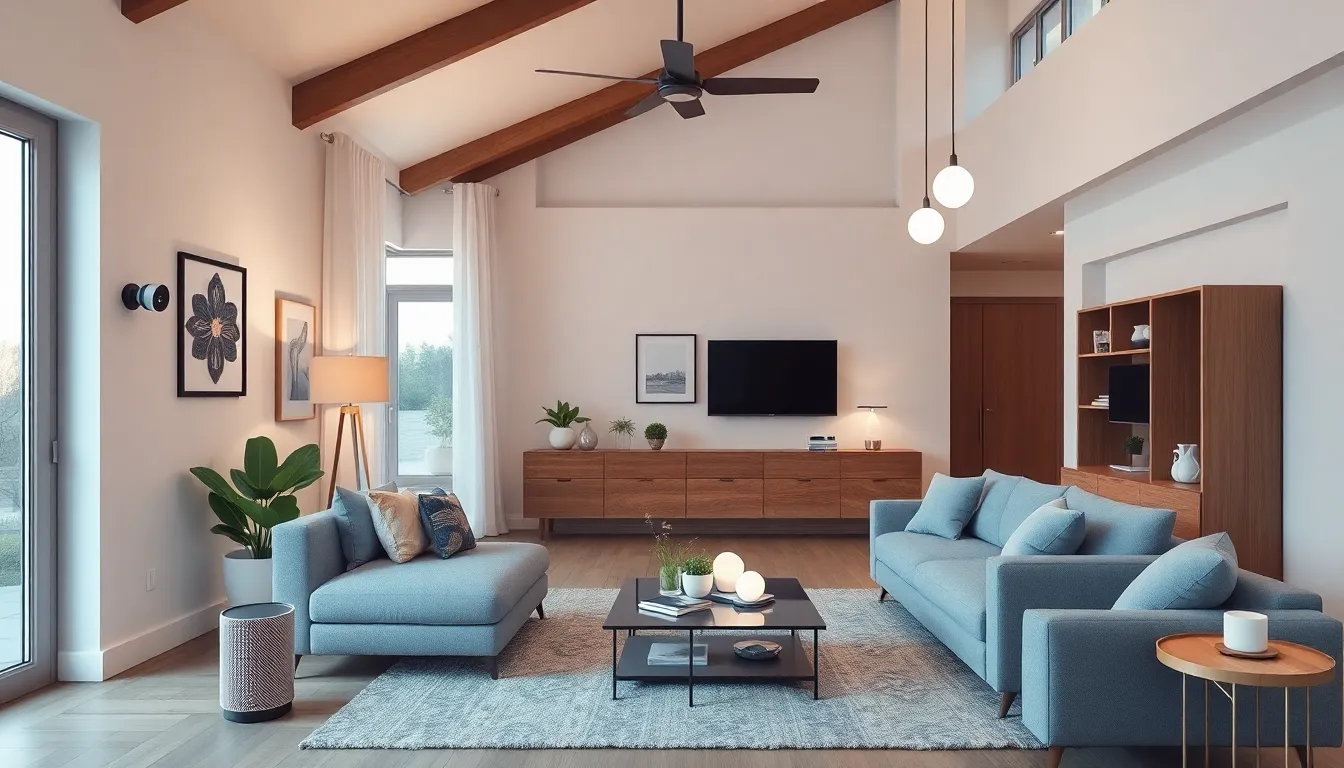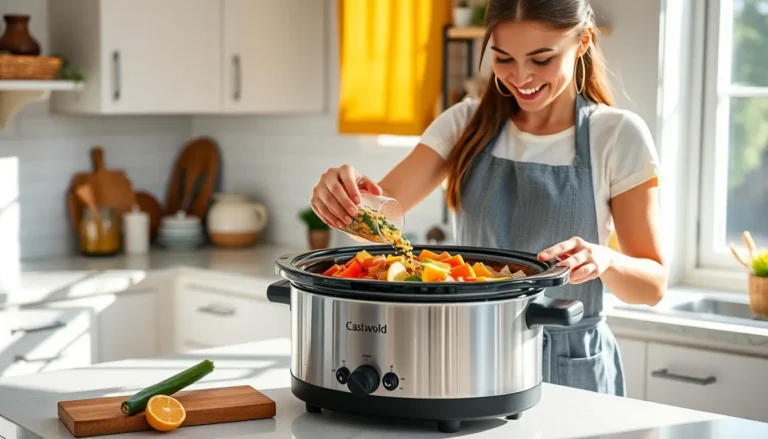Table of Contents
ToggleImagine walking into your home and having the lights turn on, the thermostat adjust, and your favorite playlist start playing—all without lifting a finger. Sounds like magic, right? Welcome to the world of home automation kits, where technology meets convenience in a way that even your couch potato self can appreciate.
What Is a Home Automation Kit?
A home automation kit combines devices and technologies that enable control over various home functions. These kits typically include smart devices like lights, thermostats, cameras, and speakers. Users interact with them through mobile apps or voice commands.
Home automation kits facilitate enhanced energy management by allowing precise adjustments to lighting and heating systems. Sensors within these kits can detect occupancy, dynamically adjusting settings to ensure efficiency. Moreover, integration with systems provides a seamless user experience.
Installation of a home automation kit usually involves connecting devices to a central hub. The hub communicates with each device, centralizing control. Some kits offer plug-and-play options, making setup straightforward even for non-technical users.
Security is another crucial aspect of home automation kits. Many include cameras and smart locks, allowing remote monitoring and access control. Users can receive alerts about unusual activity, providing peace of mind.
Interoperability among devices varies by manufacturer. Choosing a kit that supports multiple brands ensures expanded capabilities. Popular brands often feature compatibility with ecosystems like Google Assistant or Amazon Alexa.
Pricing for home automation kits ranges significantly, influenced by the number of devices included and their features. Some entry-level kits start around $100, while advanced setups can exceed $500. Individuals looking for specific functionalities can find a kit that meets their needs without overspending.
Key Features to Look For

Home automation kits enhance convenience and efficiency. When selecting a kit, certain features stand out as essential.
Compatibility
Compatibility with existing devices matters greatly. Choose kits that support numerous brands and protocols. Devices with Wi-Fi, Zigbee, or Z-Wave compatibility offer broader options. Integration with popular platforms such as Google Assistant and Amazon Alexa ensures voice control functionality. Flexibility in device selection allows for easy expansions in the future. Advancements in technology mean compatibility will continue to evolve, facilitating seamless updates and enhancements.
User-Friendly Interface
A user-friendly interface greatly impacts usability. Look for apps that provide intuitive navigation and accessible controls. Clear icons and easy-to-read setups simplify management. Compatibility with voice commands further enhances control without requiring physical interaction. Customizable dashboards can help prioritize features according to individual preferences. Responsive customer support enhances user experience, resolving any issues that might arise.
Security Features
Security features are vital in home automation kits. Users should seek cameras with high-definition video and night vision capabilities. Smart locks equipped with remote access allow for secure entry management. Alerts for unusual activities provide timely notifications for added peace of mind. End-to-end encryption ensures that personal data remains protected from unauthorized access. Additionally, two-factor authentication adds a layer of security, enhancing overall safety for users.
Popular Home Automation Kits
Various home automation kits offer innovative solutions to enhance smart home experiences. These kits vary in capabilities and features, catering to different needs and budgets.
Top-Selling Brands
Nest, Philips Hue, and SmartThings lead the market with their popular home automation kits. Nest excels in temperature control and security, with its smart thermostats and cameras offering seamless connectivity. Philips Hue specializes in smart lighting, providing customizable options for ambiance. SmartThings stands out for its versatility, supporting numerous devices across different brands. Each brand provides extensive ecosystems, allowing users to enhance their smart home setups easily.
Comparison of Features
Notable features help differentiate these popular kits. Nest includes high-definition video, remote access, and intuitive scheduling for energy savings. Philips Hue focuses on diverse light settings, enabling users to create specific moods with various colors. SmartThings offers comprehensive device compatibility, ensuring smooth integration with various protocols like Zigbee and Z-Wave. Cost varies significantly among these brands, with entry-level kits around $100 and advanced setups exceeding $500. Selecting the right kit hinges on personal preferences and specific home automation needs.
Benefits of Using a Home Automation Kit
Home automation kits offer significant advantages for users seeking convenience and control. Enhanced comfort in living spaces arises from the ability to adjust lighting and temperature settings with ease. Greater energy efficiency results from smart sensors, which optimize usage based on occupancy, reducing waste and lowering utility bills.
Security improves noticeably with the integration of smart cameras and locks. These devices provide remote monitoring capabilities, alerting homeowners to unusual activities instantly. Increased convenience comes from the central control of multiple devices through a single app or voice command, streamlining everyday tasks.
Flexibility features in these kits allow for customization based on individual needs. Users can schedule routines for lights, thermostats, and appliances, ensuring that everything operates as desired. Interoperability remains crucial; many kits support various brands and protocols, enhancing compatibility for expanded functionalities.
User-friendly interfaces contribute to a seamless experience. Intuitive apps simplify management, allowing quick adjustments without overwhelming complexity. Cutting-edge technology like voice recognition empowers users to interact with their homes effortlessly, enhancing usability.
Cost-effectiveness plays an essential role in the appeal of home automation kits. Entry-level options provide basic features, catering to beginners, while advanced setups afford extensive capabilities for tech enthusiasts. Choosing the right kit enables users to balance quality and budget effectively, ensuring they invest wisely in their home automation journey.
Setting Up Your Home Automation Kit
Setting up a home automation kit enhances convenience and efficiency in everyday life. Users can simplify their home management with an organized installation process and optimization strategies.
Installation Process
Begin by gathering all components included in your kit. Connect the central hub to a power source and Wi-Fi network. Follow the manufacturer’s instructions for pairing devices like smart lights, thermostats, and cameras. Use mobile apps for seamless setup, allowing individual devices to connect without complication. Check compatibility with existing devices to ensure smooth operation. Confirm that each device functions correctly before finalizing the installation.
Tips for Optimization
Customize settings to optimize device performance. Schedule routines for smart lights and thermostats to match personal habits. Adjust sensor thresholds based on specific occupancy patterns. Regularly update device firmware to benefit from the latest improvements. Utilize energy monitoring features to enhance efficiency, identifying patterns that lower utility costs. Explore automation integrations with voice assistants, improving control and convenience. Prioritize security by setting alerts for unusual activity and regularly monitoring camera feeds.
Home automation kits represent a significant leap toward a more efficient and secure living environment. By integrating smart devices into daily routines, users can enjoy unparalleled convenience and control over their homes. With countless options available, it’s essential to choose a kit that aligns with individual needs and preferences.
Whether prioritizing energy savings, enhanced security, or seamless device compatibility, there’s a solution for everyone. As technology continues to advance, embracing home automation not only simplifies life but also creates a smarter and more responsive home. Investing in a home automation kit is a step toward modern living that promises comfort and peace of mind.







